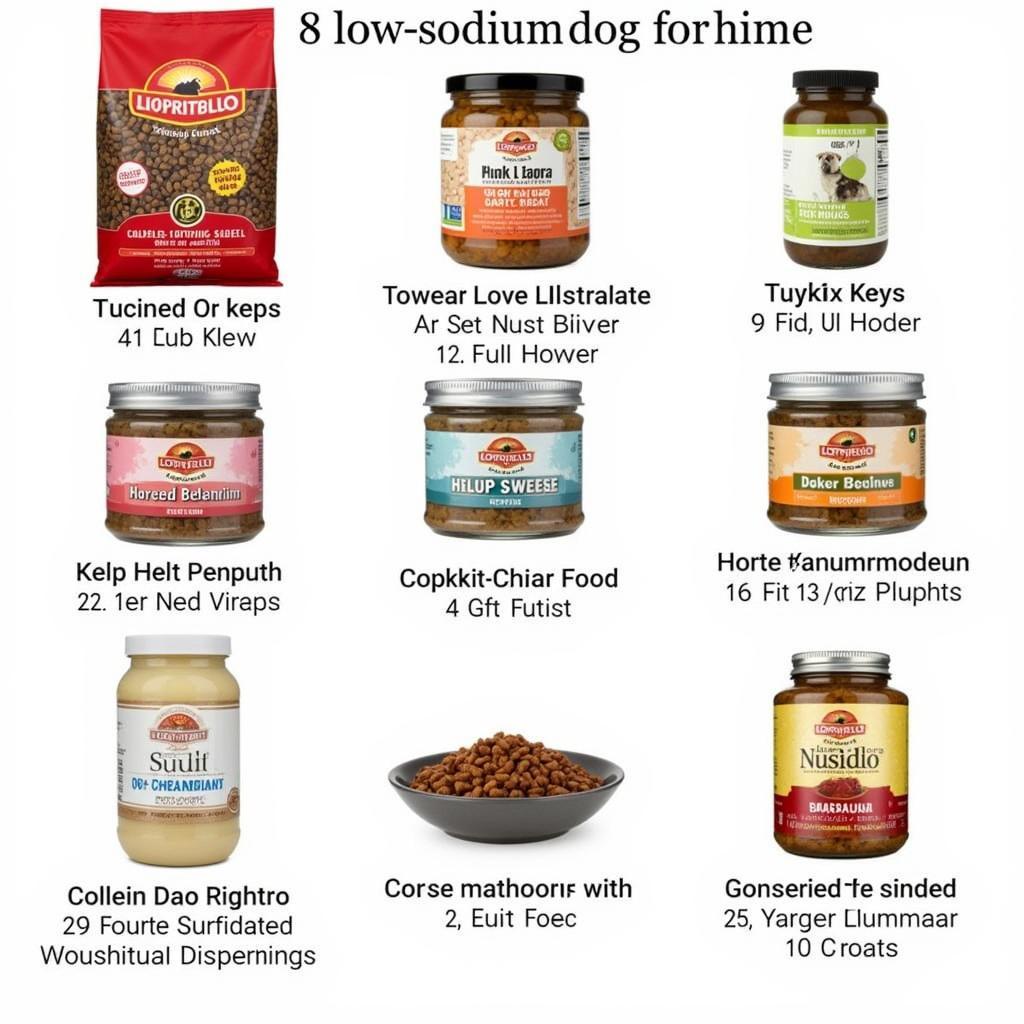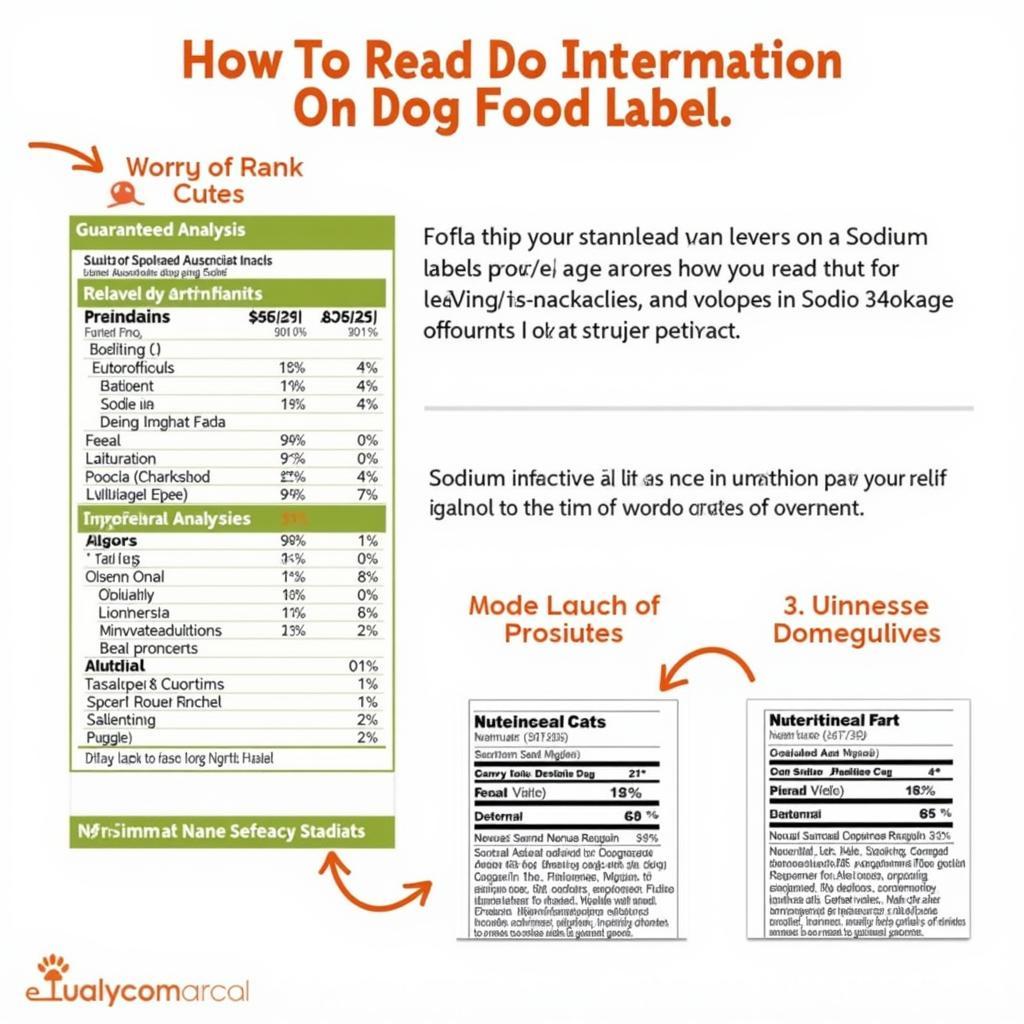Choosing Low Sodium Dog Food And Treats is crucial for your furry friend’s well-being, especially if they have certain health conditions. High sodium intake can exacerbate issues like heart disease, kidney problems, and high blood pressure in dogs. This guide will delve into the importance of a low-sodium diet, help you understand how to choose the right products, and offer tips for making the transition smoothly.
Keeping your dog’s sodium intake in check is as important as providing them with irresistible dog food. Just like in humans, too much salt can lead to a variety of health problems. While a small amount of sodium is essential for bodily functions, excessive amounts can put a strain on your dog’s organs. This is particularly true for senior dogs, puppies, and breeds prone to heart or kidney issues.
Why is Low Sodium Dog Food Important?
Sodium plays a role in maintaining fluid balance, nerve and muscle function, and overall cellular health in dogs. However, when consumed in excess, it can lead to increased thirst, frequent urination, and even water retention, putting extra stress on the kidneys. For dogs with pre-existing conditions like heart disease or kidney failure, a high-sodium diet can worsen their symptoms and accelerate disease progression. A low-sodium diet can significantly improve their quality of life and even extend their lifespan.
What are some signs of high sodium intake in your dog? Watch out for excessive thirst, increased urination, vomiting, diarrhea, and even seizures in severe cases. If you notice any of these signs, consult your veterinarian immediately. They can perform the necessary tests to determine if your dog’s sodium levels are elevated and recommend appropriate dietary changes.
 Low Sodium Dog Food Choices
Low Sodium Dog Food Choices
Choosing the Right Low Sodium Dog Food
Selecting the right low sodium dog food requires careful consideration of your dog’s individual needs. Factors such as age, breed, activity level, and any underlying health conditions should be taken into account. Reading labels carefully is essential. Look for terms like “low sodium” or “reduced sodium.” Comparing the sodium content per serving across different brands can help you make an informed decision.
Don’t hesitate to consult your veterinarian for personalized recommendations tailored to your dog’s specific requirements. They can guide you toward the most suitable options and help you create a balanced meal plan. Choosing the right food is vital for providing your pet with the nutrients they need while minimizing their sodium intake. This is especially important for dogs who need to gain weight while on a restricted diet, as detailed in our article on the best food for dogs to gain weight.
Understanding Dog Food Labels
Deciphering dog food labels can be tricky. Here’s a breakdown of what to look for:
- Guaranteed Analysis: This section lists the minimum percentages of crude protein, fat, fiber, and moisture. It also typically includes the maximum percentage of sodium.
- Ingredient List: Ingredients are listed in descending order by weight. Look for whole food sources and avoid artificial flavors, colors, and preservatives.
- Nutritional Adequacy Statement: This statement indicates whether the food meets the nutritional requirements for a specific life stage (e.g., puppy, adult, senior).
“Choosing a low-sodium diet is about more than just restricting salt,” says Dr. Emily Carter, DVM, a veterinary nutritionist. “It’s about selecting foods with wholesome ingredients that support overall health.”
 How to Read Dog Food Labels
How to Read Dog Food Labels
Low Sodium Dog Treats
Just like with their main meals, treats should also be low in sodium. Many commercial dog treats are loaded with salt, which can quickly add up and negate the benefits of a low-sodium diet. Opt for treats specifically labeled as low sodium or make your own homemade treats using low-sodium ingredients.
Remember, moderation is key. Even low-sodium treats should be given in moderation to prevent weight gain and maintain a balanced diet. Consider incorporating fresh fruits and vegetables like carrots, apples (without the core and seeds), and blueberries as healthy, low-sodium treat alternatives. These natural treats provide essential vitamins and minerals while being gentle on your dog’s digestive system. You should avoid certain foods, especially if your dog has Cushing’s disease. Check out our article on foods to avoid with Cushing’s disease in dogs for a comprehensive guide.
“Homemade treats are a fantastic way to control your dog’s sodium intake and provide them with a delicious and healthy reward,” adds Dr. Carter. “Simple recipes using ingredients like sweet potato or lean meat can be easily prepared at home.”
Transitioning to a Low Sodium Diet
Switching your dog to a low-sodium diet should be done gradually to avoid digestive upset. Start by mixing a small amount of the new food with their current food and gradually increase the proportion of low-sodium food over several days or weeks. Monitor your dog for any changes in appetite, stool consistency, or behavior. If you notice any adverse reactions, consult your veterinarian. For specific breeds like Labradors, dietary changes, especially in their senior years, need to be approached carefully. Our article on the best senior dog food for labradors can offer helpful insights.
Conclusion
Choosing low sodium dog food and treats is a vital step in protecting your dog’s health, especially for those with existing health conditions. By understanding the importance of low sodium, reading labels carefully, and transitioning your dog’s diet gradually, you can ensure your furry companion enjoys a long, healthy, and happy life. Remember, providing unrefined smoked salmon dog food as an occasional treat is acceptable, as long as it fits within their overall low-sodium dietary plan.
FAQ
- What is considered a low-sodium dog food?
- Can I make my own low-sodium dog treats?
- How do I transition my dog to a low-sodium diet?
- What are the signs of high sodium intake in dogs?
- Are there any specific breeds that require a low-sodium diet?
- What are some healthy, low-sodium treat alternatives?
- How often should I give my dog treats, even if they are low sodium?
For any further assistance, please contact us at Phone Number: 02437655121, Email: minacones@gmail.com Or visit our address: 3PGH+8R9, ĐT70A, thôn Trung, Bắc Từ Liêm, Hà Nội, Việt Nam. We have a 24/7 customer support team.